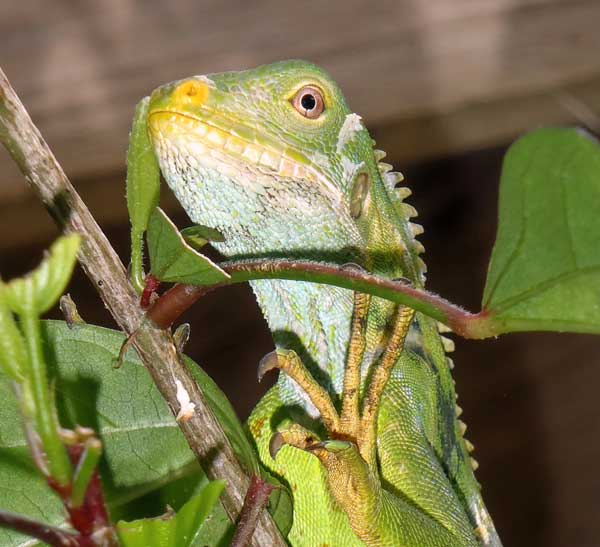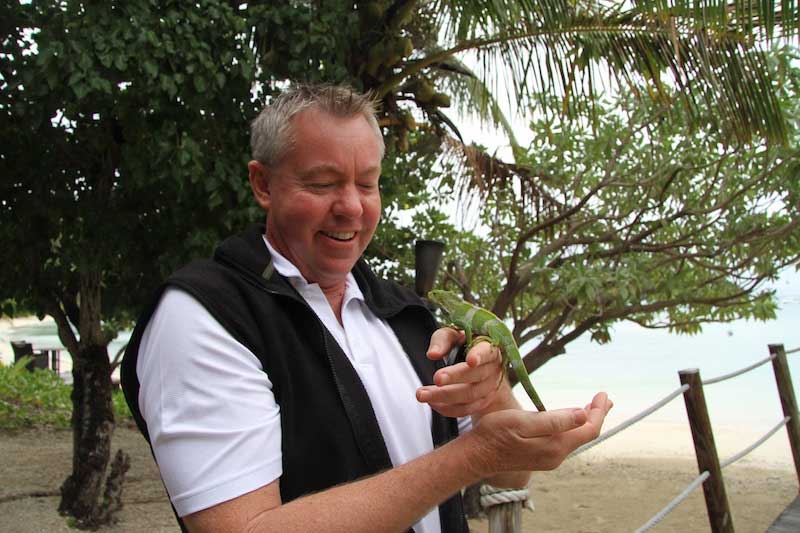They are probably the most famous Iguanas in the Pacific.
Meet Malolo and Likuliku, the two Fiji crested iguanas at the magical Likuliku Lagoon Resort in the Mamanuca Group of islands.
In a haven of subtle luxury, embraced by the renowned warmth of its workers, the two iguanas seem to know that they are celebrities.
They pose, with attitudes of total indifference for photographs.
And many guests who have visited Likuliku Lagoon Resort, the first and only resort in Fiji with over-water bures, are trailing the iguanas progress and fame on facebook.
The Fiji crested iguana (Brachyllophus Vitiensis) was feared extinct on Malolo so when in January 2011, a 33.5 centimetre long iguana weighing just 19 grams was found in a hibiscus tree at Malolo Island Resort there was much excitement.
Ten months later another slightly larger iguana was found at Likuliku Lagoon measuring 37 and weighing 29 grams.
Both have been named after their place of origin.
The discovery of these two critically endangered species (ICUN list 2006) is a reminder of the need to protect natural habitats so “future generations can also enjoy the flora and fauna of Fiji,” said Steve Anstey, the Group General Manager for Ahura Resorts.
Mr Anstey who is also the Treasurer of the Mamanuca Environment Society (MES) said Iguanas were thought to have been extinct on the Island of Malolo and this made there discovery even more exciting.
He said the Fiji Crested Iguana is known to exist on the lesser populated islands in the north such as Monuriki and just recently one was found on Qalito, home to Casatway Island Resort.
However, their recorded numbers are fast diminshing along with their natural habitiat the Dry Forest.
Mr Anstey said the discovery of Malolo and Likuliku transformed their perspective and the scope of their environmental initiatives.
“MES which has historically been marine based in its endeavours also realised that there was some wonderful land based flora and fauna that needed just as much care and attention as our marine preserves.”
“The Fiji Crested Iguanas are actually on the same level as the Panda Bear in terms of extinction and people don’t realise that how important these creatures are. They are fascinating animals, prehistoric in many ways and we should be taking every effort to preserve them.”
“We hope that with further discoveries we will start our own breeding program which will enable us to systematically release them back into their natural habitat.”
Mr Anstey believed there are three main factors that have seen the decline in number of the Fiji Crested Iguanas.
“The first is the loss of their natural habitat. The Dry Forest that should cover all of the large islands in the Mamamnucas are all but gone. Remnants remain in isolated pockets and in island gullys. The Dry Forest ironically enough is also one of the most endagered eco systems in the world.”
“All the larger islands in the Mamanucas for instance should be covered just like Qalito and Monuriki. Now most are just covered with grass. The other two factors have been the introduction of goats that compete with iguanas for food and also wild cats have had a terrible effect on numbers.”
Mr Anstey said they are working closely Kula Eco Park, San Diego Zoo and Sydney’s Taronga Zoo as they are well aware of the complexities involving raising Iguanas.
“In fact, Ramesh Chand from Kula Park, Peter Harlow from Taronga Zoo and Robert Fisher from the San Diego Zoo have visited the island twice since we found the iguanas firstly to assess them, take DNA samples and secondly to do a search and count for any adult population that we know must be around”
“Unfortunately the weather was not conducive for a thorough search of the forest areas. They are very hard to find as they live high up in the trees canopy and search is done at night with spotlights.”
“The females Fiji Crested Iguanas only come down to ground once a year to lay their eggs in the sand usually during the wet season. They are oviparous and have one of the longest incubation periods of any reptile. The eggs take approximately 189 days (6 to 7 months) to hatch.”
“The Fiji Crested Iguanas are herbivorous feeding on leaves, fruit, flowers of trees and shrubs. Our Iguanas follow a very strict controled diet which includes a balance of fruits, vegetables and flowers,” said Mr Anstey.
By April 2012, Malolo has grown to 39.3centimetre and weighs 51.9 grams while Likuliku is 99.1centimetre long and weighs 49grams so we are pleased with their progress.
The discoveries of the iguanas have lead to a rethink and the Iguanas and Dry Forest now form a crucial part of our Ahura Resorts Environmental Policy.
According to Mr Anstey, they have already planted over one thousand dry forest species on their lease since they found the Iguanas and they are collecting more to start their own propagation program.
There is hope, he said, that one day they will be able to allow each guest to plant a tree during their stay.
And they are working hand in hand with land owners and the Ministry of Forestry over the issue of revegetating the lease.
Apart from the loss of the vegetation, Mr Anstey said the Dry Forests are also home to a variety of animals including the Bolo Snakes and Pacific Boas and also the Ogea Monarch, Red Throated Lorikeets, Falcon and Fiji Parrot Finches.
Unfortunately some species like the Grass owl are already extinct- never to be seen again.
While the work will take many years, Mr Anstey said the mission is a must do and they are on course to actually carrying it out.
“It is also about the people and the culture. It is about providing opportunities for improving and helping island communities and individuals through the development of businesses that provide jobs, training and on going development without compromising or taking advantage of the culture or the people involved.”
“We are active members of the Mamanuca Environment Society (MES) providing on- going training and education to resort staff, guests and the village people in the preservation and caring for the environment,” added Mr Anstey.



